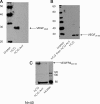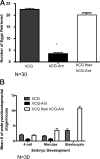A unique human chorionic gonadotropin antagonist suppresses ovarian hyperstimulation syndrome in rats
- PMID: 19443574
- PMCID: PMC2717881
- DOI: 10.1210/en.2009-0107
A unique human chorionic gonadotropin antagonist suppresses ovarian hyperstimulation syndrome in rats
Abstract
Ovarian hyperstimulation syndrome (OHSS) is a complication of in vitro fertilization associated with physiological changes after hCG administration to induce final oocyte maturation. It presents as widespread increases in vascular permeability and, in rare cases, results in cycle cancellation, multi-organ dysfunction, and pregnancy termination. These physiological changes are due primarily to activation of the vascular endothelial growth factor (VEGF) system in response to exogenous human chorionic gonadotropin (hCG). An hCG antagonist (hCG-Ant) could attenuate these effects by competitively binding to the LH/CG receptor, thereby blocking LH activity in vivo. We expressed a form of hCG that lacks three of its four N-linked glycosylation sites and tested its efficacy as an antagonist. The hCG-Ant binds the LH receptor with an affinity similar to native hCG and inhibits cAMP response in vitro. In a rat model for ovarian stimulation, hCG-Ant dramatically reduces ovulation and steroid hormone production. In a well-established rat OHSS model, vascular permeability and vascular endothelial growth factor (VEGF) expression are dramatically reduced after hCG-Ant treatment. Finally, hCG-Ant does not appear to alter blastocyst development when given after hCG in mice. These studies demonstrate that removing specific glycosylation sites on native hCG can produce an hCG-Ant that is capable of binding without activating the LH receptor and blocking the actions of hCG. Thus hCG-Ant will be investigated as a potential therapy for OHSS.
Figures





Similar articles
-
Prevention of the onset of ovarian hyperstimulation syndrome (OHSS) in the rat after ovulation induction with a low molecular weight agonist of the LH receptor compared with hCG and rec-LH.Endocrinology. 2011 Nov;152(11):4350-7. doi: 10.1210/en.2011-1077. Epub 2011 Sep 6. Endocrinology. 2011. PMID: 21896671
-
Effects of gonadotropin-releasing hormone antagonists on the expression of vascular endothelial growth factor and its receptors in a rat model of ovarian hyperstimulation syndrome.Chin Med J (Engl). 2008 Dec 5;121(23):2434-9. Chin Med J (Engl). 2008. PMID: 19102964
-
Comparison of Steroidogenic and Ovulation-Inducing Effects of Orthosteric and Allosteric Agonists of Luteinizing Hormone/Chorionic Gonadotropin Receptor in Immature Female Rats.Int J Mol Sci. 2023 Nov 22;24(23):16618. doi: 10.3390/ijms242316618. Int J Mol Sci. 2023. PMID: 38068943 Free PMC article.
-
The role of vascular endothelial growth factor and interleukins in the pathogenesis of severe ovarian hyperstimulation syndrome.Hum Reprod Update. 1997 May-Jun;3(3):255-66. doi: 10.1093/humupd/3.3.255. Hum Reprod Update. 1997. PMID: 9322101 Review.
-
The prevention of ovarian hyperstimulation syndrome.J Obstet Gynaecol Can. 2014 Nov;36(11):1024-1033. doi: 10.1016/S1701-2163(15)30417-5. J Obstet Gynaecol Can. 2014. PMID: 25574681 Review. English, French.
Cited by
-
Revisiting ovarian hyper stimulation syndrome: Towards OHSS free clinic.J Hum Reprod Sci. 2015 Jan-Mar;8(1):13-7. doi: 10.4103/0974-1208.153120. J Hum Reprod Sci. 2015. PMID: 25838743 Free PMC article. Review.
-
Association between the luteinizing hormone/chorionic gonadotropin receptor (LHCGR) rs4073366 polymorphism and ovarian hyperstimulation syndrome during controlled ovarian hyperstimulation.Reprod Biol Endocrinol. 2013 Jul 25;11:71. doi: 10.1186/1477-7827-11-71. Reprod Biol Endocrinol. 2013. PMID: 23883350 Free PMC article.
-
Dominant follicle-targeted nanocarriers for GH delivery to alleviate premature ovarian insufficiency.Mater Today Bio. 2025 Jun 11;33:101930. doi: 10.1016/j.mtbio.2025.101930. eCollection 2025 Aug. Mater Today Bio. 2025. PMID: 40600179 Free PMC article.
References
-
- Kovács P, Mátyás S, Kaali SG 2006 Effect of coasting on cycle outcome during in vitro fertilization/intracytoplasmic sperm injection cycles in hyper-responders. Fertil Steril 85:913–917 - PubMed
-
- Cohen BM 2008 Role of human albumin in ovarian hyperstimulation syndrome. Fertil Steril 89:1845–1846 - PubMed
-
- Justice HM, Counselman FL 2008 Ovarian hyperstimulation syndrome: an important complication of in vitro fertilization. Am J Emerg Med 26:115.e3–115.e4 - PubMed
-
- Manno M, Tomei F 2008 Mechanism of severe ovarian hyperstimulation syndrome. Fertil Steril 89:1843; author reply 1843–1844 - PubMed

